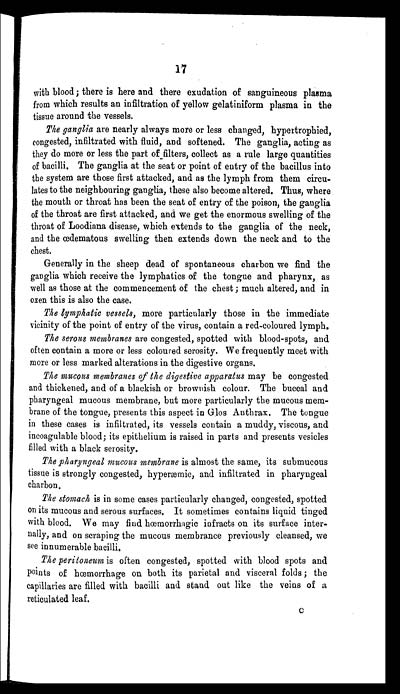Medicine - Veterinary > Civil Veterinary Departments > Civil Veterinary Department ledger series I-VI > Volume II - Anthrax
(129) Page 17
Download files
Individual page:
Thumbnail gallery: Grid view | List view

17
with blood ; there is here and there exudation of sanguineous plasma
from which results an infiltration of yellow gelatiniform plasma in the
tissue around the vessels.
The ganglia are nearly always more or less changed, hypertrophied,
congested, infiltrated with fluid, and softened. The ganglia, acting as
they do more or less the part of filters, collect as a rule large quantities
of bacilli. The ganglia at the seat or point of entry of the bacillus into
the system are those first attacked, and as the lymph from them circu-
lates to the neighbouring ganglia, these also become altered. Thus, where
the mouth or throat has been the seat of entry of the poison, the ganglia
of the throat are first attacked, and we get the enormous swelling of the
throat of Loodiana disease, which extends to the ganglia of the neck,
and the œdematous swelling then extends down the neck and to the
chest.
Generally in the sheep dead of spontaneous charbon we find the
ganglia which receive the lymphatics of the tongue and pharynx, as
well as those at the commencement of the chest ; much altered, and in
oxen this is also the case.
The lymphatic vessels, more particularly those in the immediate
vicinity of the point of entry of the virus, contain a red-coloured lymph.
The serous membranes are congested, spotted with blood-spots, and
often contain a more or less coloured serosity. We frequently meet with
more or less marked alterations in the digestive organs.
The mucous membranes of the digestive apparatus may be congested
and thickened, and of a blackish or brownish colour. The buccal and
pharyngeal mucous membrane, but more particularly the mucous mem-
brane of the tongue, presents this aspect in Glos Anthrax. The tongue
in these cases is infiltrated, its vessels contain a muddy, viscous, and
incoagulable blood; its epithelium is raised in parts and presents vesicles
filled with a black serosity.
The pharyngeal mucous membrane is almost the same, its submucous
tissue is strongly congested, hyperæmic, and infiltrated in pharyngeal
charbon.
The stomach is in some cases particularly changed, congested, spotted
on its mucous and serous surfaces. It sometimes contains liquid tinged
with blood. We may find hœmorrhagic infracts on its surface inter-
nally, and on scraping the mucous membrance previously cleansed, we
see innumerable bacilli.
The peritoneum is often congested, spotted with blood spots and
points of hœmorrhage on both its parietal and visceral folds; the
capillaries are filled with bacilli and stand out like the veins of a
reticulated leaf.
C
Set display mode to: Large image | Zoom image | Transcription
Images and transcriptions on this page, including medium image downloads, may be used under the Creative Commons Attribution 4.0 International Licence unless otherwise stated. ![]()
| India Papers > Medicine - Veterinary > Civil Veterinary Departments > Civil Veterinary Department ledger series I-VI > Anthrax > (129) Page 17 |
|---|
| Permanent URL | https://digital.nls.uk/75516159 |
|---|




